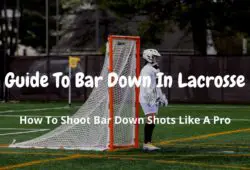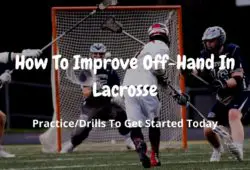In lacrosse, players are constantly running and sprinting up and down the field. Which means you have to be able to maintain possession of the ball while moving at a high speed. In order to do so, players cradle the stick to keep the ball inside the pocket. Essentially cradling is a back-and-forth wrist curling motion, so try to keep your arms, wrists and shoulders nice and loose to maintain a comfortable grip.
This is an essential lacrosse skill you need to master especially for players just starting out. Possession wins the game. When you don’t have a great cradling skill to maximize your possession time and minimize the chance of dropping the ball, it can cost a turnover. Furthermore, regardless of what position you want to play, a good cradling skill is required.
Thus, in this post, I will go over everything you need to know about cradling, how to train and how to master the skill so you are able to retain the ball even when you are getting hard checks.
Also check out all the “How To” guides I wrote on the fundamental lacrosse skills you need to master
How Does Cradling Work Exactly?
If we speak in physics terms, the reason why cradling works is due to centripetal force. If you simply hold the stick without rotating it back and forth, the ball is very likely to bounce off of the pocket.
This idea is similar to riding a roller coaster. Riders don’t fall out of their seats at the top of the motion thanks to centripetal force. Hence, by cradling the lacrosse ball, it maximizes its ability to stay inside the pocket even in the face of defensive checks.
One important note is that you aren’t trying to spin the ball as fast as possible; rather, you are curling the stick back and forth with your wrists in a loose and fluid motion.
Key Steps To Cradling And Protecting A Lacrosse Ball

Two hand cradling
If you are just starting off, begin with learning how to cradle with two hands where you want to keep both hands far apart. Place your dominant hand near where the shaft meets the plastic head and place your non-dominant hand at the very bottom of the lacrosse shaft. This is different from shooting hand placement.
Another great benefit to this type of cradling is that it gives you the most security when being checked or sprinting across the field.
Gripping the stick
Your dominant hand grips the shaft with your palm facing you. Similar to when you hold a dumbbell in curling. Your non-dominant hand grips the shaft with an overhand grip, similar to gripping a bicycle handle.
Curling
Keep your non-dominant hand fixated near the butt end of the shaft as a guiding hand. Use your dominant hand to curl the stick back and forth like you are flexing the biceps and bring your dominant hand towards your helmet. This motion should be done in a fluid and smooth rhythm.
For visual learners, the video below also captures all the key points you need to learn about how to cradle a lacrosse ball.
Beginner Cradling Tips
Pocket formation
Pockets directly impact the hold of the ball. Not having a deep enough pocket could hinder your ability to cradle.
If the pocket is too shallow, the ball is very easy to get bounced off the pocket. In contrast, if the pocket has sufficient depth the ball could safely remain inside and not raddle around.
A good rule of thumb is to hold out your stick horizontally, the ball should not be visible above the rim of the head. If it appears to be too shallow, ask your coach or a local store to help you adjust the pocket as well as make sure it’s not too deep that becomes illegal.
Cradle Vertically
Beginners tend to cradle the ball horizontally as it’s easier to cradle and maintain possession. However, this isn’t a good practice as defensive players have a better chance of throwing checks and regaining possessions.
So as your experience continues to grow, get comfortable with cradling vertically to keep your stick close to your helmet at all times. This way it’s harder for an opponent to steal the ball at the same time the opponent will be less like to slash you in avoidance of drawing a penalty.
Keep the ball on the side opposite of the opponents
Because we are trying to utilize every opportunity to stop opponents from stealing the ball, use your body to protect the ball. Put your body between your opponents and the ball to form a natural blockage.
Cradling Drills
To truly master the fundamentals of cradling, you must be slow and patient in the beginning. The most basic form is to start with a stationary position. Practice two hands cradling and switch hands after cradling 1000 times every time.
Focus on working on cradling movements of your wrist. And then gradually integrate the movement of your arm to do the full cradling motion. Once you are comfortable with a stationary cradling, time to add more complexity.

In a real match, you rarely cradle standing still, so now it’s time to cradle and move at the same time. This will require movement coordination. You can start by jogging and then transition from normal running to sprinting.
Still use two hand cradling while running down the field. Switch sides once you have done a full leap. Also feel free to apply defensive pressure by a teammate while you are cradling.
Before we go into one-handed lacrosse cradles you want to make sure cradling with two hands has become second nature. From there, start practicing one-handed cradling as this is the better way to protect the ball as you have more space to shield the ball away from your opponents.
In this video below you will also find great cradling drills to continue improving your handling and ball possession:
Conclusion
As we wrap up the discussion on cradling, I want to make sure we have covered everything you need to know. If there’s anything that is unclear or missing, please drop me a comment.
In summary, cradling is a back-and-forth wrist-curling motion and the goal is to be able to move freely across the field without losing control. Lastly, try to practice as often and consistently as you can.
Please check out more training guides:





